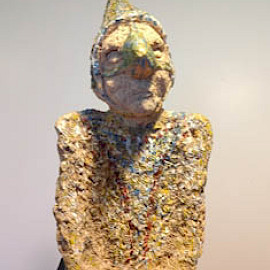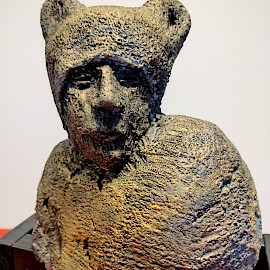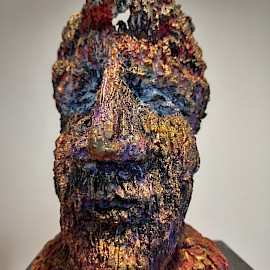Previous exhibitions
Taidekeskus Ahjo, Sysi-sali: Esko-Pekka Tiitinen
TARINANKERTOJAN KUUDES TALVI (THE SIXTH WINTER OF THE STORYTELLER)
ESKO-PEKKA TIITINEN
14.02.-03.03.2024, SYSI HALL
The questions of this interview were prepared by the clay sculpture in the picture: "Faktantarkastaja" (Fact Checker)
"Sixth winter of the storyteller" Where does the name come from?
The name of the exhibition could have been a retro-depressive exhibition of Esko, Pekka and Olavi Tiitinen, identical brothers, but when I looked at the finished works, I realized that the characters I depicted started to have a lot of positive things to tell the viewer. "Sixth winter of the storyteller" was the name suggested for one of my sculptures, good, because the characters appearing in my pictures are the tellers of the stories in my exhibition. Just like the main stage of a theater performance is not on the stage but between the audience's ears.
You have collected hundreds of works, paintings, sculptures and drawings from four decades in your retrospective exhibition. Has your relationship with visual arts or writing changed over time?
I haven't noticed any big changes. Of course, I couldn't bring my public works to this exhibition, but in my small and large works I have combined several different techniques since my youth. It has been important for me that I have been able to keep visual art. literature, music and theater production at the same time above.
The idea chooses the implementation. Sometimes it has been better to make song lyrics based on an idea instead of a painting. Sometimes a book is born from an idea. All art forms support each other.
What does making fine art give you?
Initially, white paper is mute for me, but in the working phase the person I am photographing starts to tell the story of his life, line by line, with brushstrokes or growing from the clay. This is a remarkable creative process in which I am present as the implementer. At the same time, of course, they also tell something about my own life. I am often surprised how much they remember things, but mostly their stories extend to all levels of society. Sometimes the tyrants shout their theses, sometimes I have to beat the already-born clay type to the floor, sometimes I scrub the person's mouth off with turpentine so that it doesn't talk so much shit. Often they are also gracious and give good suggestions on how we should organize our lives so that the bread lines would disappear.
Do the people you portray have counterparts in reality?
When I paint, I don't use individual models, but the figures come from the back of my mind, they often resemble each other, they are a uniform, colorful race of people and animals, which often don't have things quite right. I am a passionate draftsman and sketcher. Sometimes when I listen to and watch the news on TV, I get a dictator's nose on paper, a presidential candidate's blurry eyes, a terrorist's ears, a lonely old man's forehead wrinkles and brittle hair. I've also drawn the characters of my novels and short stories, held them in front of me while I wrote, and then seen which could survive, the drawing or the writing.
What do you want to tell viewers with your photos?
Although I give names to my artworks, I still hope that the outside viewer can start their own dialogue with the picture and come up with their own name and story for the work. I hope that the frozen image in the hell of war of this time would give us the opportunity to stop and think, especially those who have things worse. We still have some time to think about what the plants and animals would think of our current spending.
Esko-Pekka Tiitinen (born 1956) is a visual artist and writer. His visual art has been exhibited in numerous exhibitions in Finland and abroad. He has written about forty books, and they have been published in eleven countries. His plays have been performed in numerous city theaters and amateur groups.



